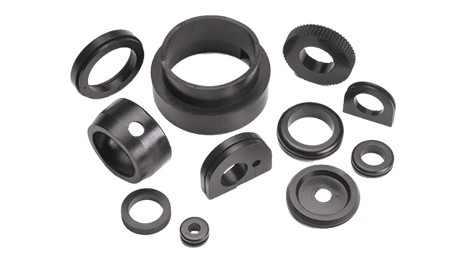
When it comes time to invest in rubber and plastic parts, not all materials are created equal. There are a massive number of compounds used to address different performance requirements, environments, and other factors – and some will do a much better job than other for your exact application.
Nitrile rubber, also known as Buna-N among other names, is one such option for particular parts. Let’s break down what nitrile is, what makes it a useful material for parts, and which industries typically benefit from it.
What is Nitrile Made Of?
Before nitrile is made into everything from gaskets to disposable gloves, it has to be manufactured. Nitrile is a synthetic rubber copolymer that is created when acrylonitrile (ACN) and butadiene are bonded together using polymerization. The resulting material is appropriately known as Nitrile Butadiene Rubber (NBR) in addition to just Nitrile or Buna-N.
After the polymerization process, NBR is formed into a sheet rubber. The sheet rubber goes through vulcanization with different ingredients to improve certain performance qualities like elasticity, puncture resistance, and more. The resulting compound can then be die cut, extruded, or manufactured some other way into a variety of parts.
What are the Advantages of Using Nitrile?
Like many other rubber and plastic compounds, nitrile boasts a variety of benefits. Some of its best qualities include the following advantages.
Nitrile offers high resistance to oils, fuels, and other chemicals
Nitrile is one of the best material options for any parts that come in contact with oils, fuels, and other chemicals, such as acids, greases, and solvents. NBR is much more resistant than natural rubber and most other synthetic compounds, which is why it’s often used in automotive applications and other applications with constant oil exposure.
High tensile strength
Nitrile has excellent tensile strength, boasting a PSI range of 200-3,000 and max elongation of 600%. These capabilities mean this particular material can stretch without losing shape and resist tearing, making it more durable than many other materials used for seals and other parts.
Good resistance to heat
Nitrile is a rubber material that can withstand temperatures ranging from -40°F (-40°C) up to 250°F (121°C). This temperature range makes NBR an ideal base compound for applications that can operate in extreme temperatures and offer other benefits.
Good abrasion resistance
If you need a material that can take a beating, nitrile is a viable option. This material is resistant to abrasion, punctures, and tears, making it ideal for hydraulic hoses, gaskets, and any other parts that need to survive from repeated contact or regular abrasion over time.
Low permeability
Nitrile rubber has one of the lowest permeability rates among synthetic elastomers, which means that it seals well against many liquids and gases (including oil products, fuels, and hydrocarbons). These qualities make Buna-N an excellent candidate for gaskets and sealing solutions.
Are There Situations Where Nitrile isn't a Good Fit?
Nitrile is a durable material that can withstand high temperatures and pressures, but it isn't suitable for every situation. For example, this particular material is susceptible to ozone degradation. If you're looking for a more weather-resistant material, ethylene propylene diene monomer (EPDM) is a versatile solution.
The overall cost is another consideration when choosing the suitable material for your application. As a specialty material with excellent resistances, nitrile can costs more than other common materials. If your application doesn't need the same performance level as nitrile, you might opt for a more cost-effective part solution.
What is Nitrile Rubber Used For?
Thanks to it’s range of performance capabilities, there are a variety of parts made with NBR. Everything from floor mats to bowling equipment can benefit from this particular material. Some of the more common uses of nitrile rubber include:
- Automotive parts
- Gaskets and seals
- Fuel systems and hoses
- Tubing
- Fuel pump diaphragms
- Oil and gas parts
- Seals and tubing
- Connectors
- Blowout preventers
- Boned components and molded shapes
- Rotating heads
- Bowling parts
- Pin setters
- Roller bumpers
Find the Best Material for Your Part Needs
While there are several types of rubber available, nitrile is an excellent general-purpose material that you can use in many different ways. Thanks to its many desirable properties and ease of processing, this particular rubber compound is ideal for creating various molded, extruded, and die cut parts.
With all the options available, it’s not always easy to uncover the best part solution. Our experts thoroughly analyze your needs to recommend the most effective material for your performance requirements and budget. Give us a call at 800-969-6242 or contact us online to talk to one of our experts about the parts you need.
